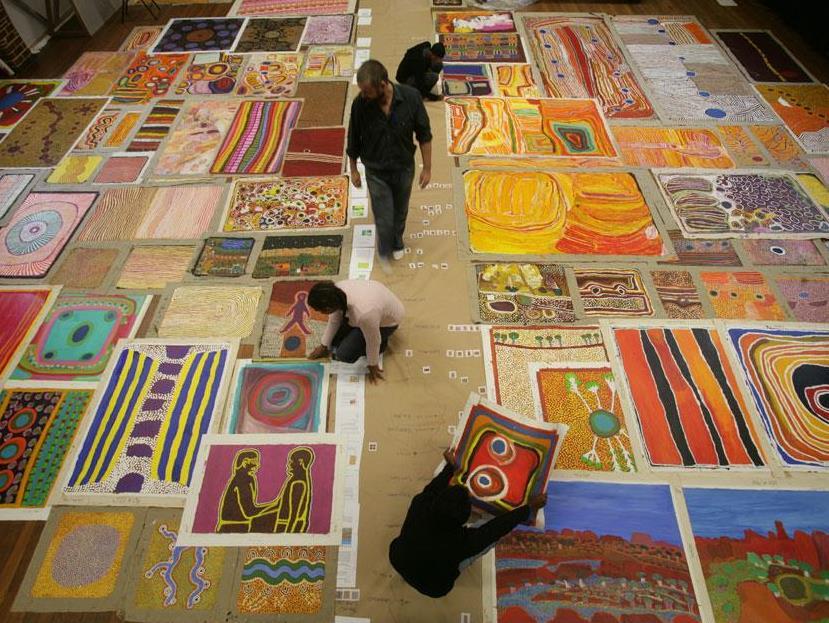Co-curators Hayley Aykins, John Carty, Louise Mengil and Terry Murray at work with the Canning Stock Route collection. Photo by Ross Swanborough, 2008
It usually happens at a young age that one first recognises that looking at a painting is something out of the ordinary. This experience is usually followed by the initiate choosing to study art at secondary school level, both as a student of art history and as a practitioner. While there are no definitive rules to follow to succeed in this profession there are certainly ways of ensuring that one is equipped to cope with both the pitfalls and the rewards. Therefore outlined here are ten tips to becoming a curator:
1. Firstly, being a curator one should think of a series of paintings in terms of the form and the content of the work. When curating a show one may be more inclined to structure it in terms of giving priority to one of these without losing sight of the other.
2. It is advisable to spend many hours in galleries looking at art and to recognise in the process of viewing art what it means to look into a painting – to see the way the use of paint has been layered and the techniques of its application without losing sight of the ideas that emerge in ‘the looking’.
3. Early experimentation might involve getting a gig to curate a show around a theme that interests you. Broadly speaking you should know what fascinates you and the kind of art that you think you can bring something extra to by the way you decide to present the work. One might think of a community center that would welcome your presentation of an idea that you think will engage that particular audience. Alternatively there may be a body of work that emerges from a community that you decide to bring together in an exhibition. In this circumstance it will be the body of work itself that will determine your theme.
4. The first experience of curating should involve your providing a catalogue essay for that exhibition. It should clearly outline what it is in the art selected that brings it together and it should be clear from this essay that a great deal of wrestling with the form and content of this work has occurred.
5. The first experience will bring you face to face with the difficulties and the rewards and it will tend to be the difficulties that become your instructor for the future. One of these is dealing with the artists themselves who believe that it is their artwork and therefore their call on how it might be presented. Therefore it is crucial that before you hang the paintings that you have built up a trust with each of the artists involved. He or she must feel that their work is the nexus of your project and that your wish is to communicate the value of their work to an audience.
6. At this point you will experience both failure and success and you will have begun to recognise your strengths and your weaknesses, and this is when it is important to have a mentor- someone who you trust and someone you are prepared to hear negative as well as positive comments about your work from.
7. No matter how small the exhibition is and no matter how removed it may be from the central activity of art in your city, it is advisable to secure some kind of publicity for the exhibition. This is one of the most time-consuming and yet necessary activities to master for a curator in the making. Local newspapers, radio shows and of course social media is of paramount importance and you need to overcome any lack of confidence that tends to emerge when you need to publicise an event and/or receive reviews about that show.
8. As soon has you have successfully curated a few shows you should set up a blog and/or website and advertise the fact of the events. Interviewing locals at the exhibition about their response to the art is good way of interesting a wider audience in your work.
9. While all the above is occurring you need to remember that you can never know all there is to know about art but that you should never stop learning more, whether this is achieved by studying art at a formal level or self education, always remembering to listen to mentors and all people you come across in the art world who have something unique to impart to you.
10. Finally – in the end you need to create your own opportunities and to seek out all possibilities that might provide you an opportunity to curate exhibitions. The more you do, the better you will be, though if you feel at the end of each show that something could have been better then you are on pathway to success because the art of the curator is to travel a number of roads that will never ultimately lead you to a final destination.
Curating art exhibitions engages with that relentless search for meaning; it allows you to enter the ‘head space’ of others and be a conduit to a larger audience who in turn learn something new. This is akin to that early childhood experience of first truly looking into a painting and seeing life differently – that is experiencing something transformative.





